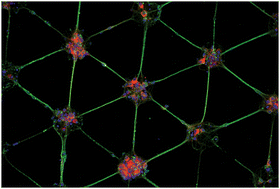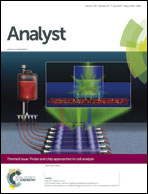Micropatterning neuronal networks†
Abstract
Spatially organised neuronal networks have wide reaching applications, including fundamental research, toxicology testing, pharmaceutical screening and the realisation of neuronal implant interfaces. Despite the large number of methods catalogued in the literature there remains the need to identify a method that delivers high pattern compliance, long-term stability and is widely accessible to neuroscientists. In this comparative study, aminated (polylysine/polyornithine and aminosilanes) and cytophobic (poly(ethylene glycol) (PEG) and methylated) material contrasts were evaluated. Backfilling plasma stencilled PEGylated substrates with polylysine does not produce good material contrasts, whereas polylysine patterned on methylated substrates becomes mobilised by agents in the cell culture media which results in rapid pattern decay. Aminosilanes, polylysine substitutes, are prone to hydrolysis and the chemistries prove challenging to master. Instead, the stable coupling between polylysine and PLL-g-PEG can be exploited: Microcontact printing polylysine onto a PLL-g-PEG coated glass substrate provides a simple means to produce microstructured networks of primary neurons that have superior pattern compliance during long term (>1 month) culture.

- This article is part of the themed collection: Probe and chip approaches to cell analysis

 Please wait while we load your content...
Please wait while we load your content...